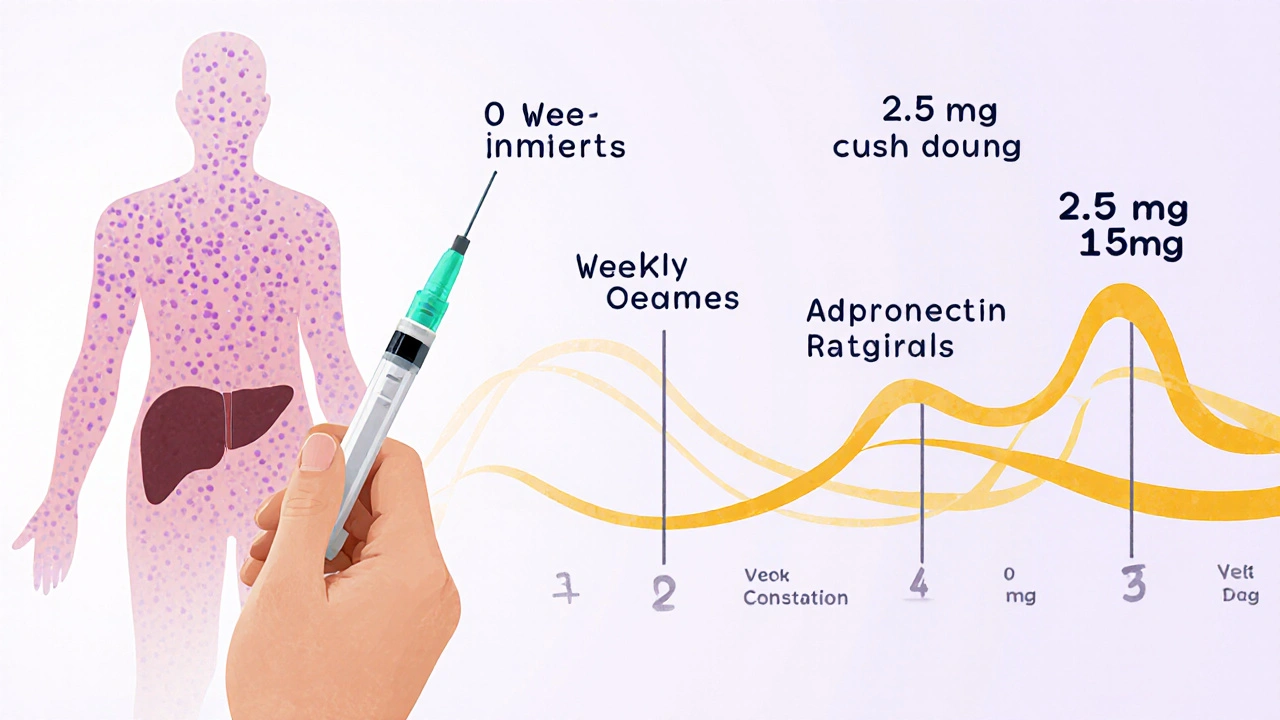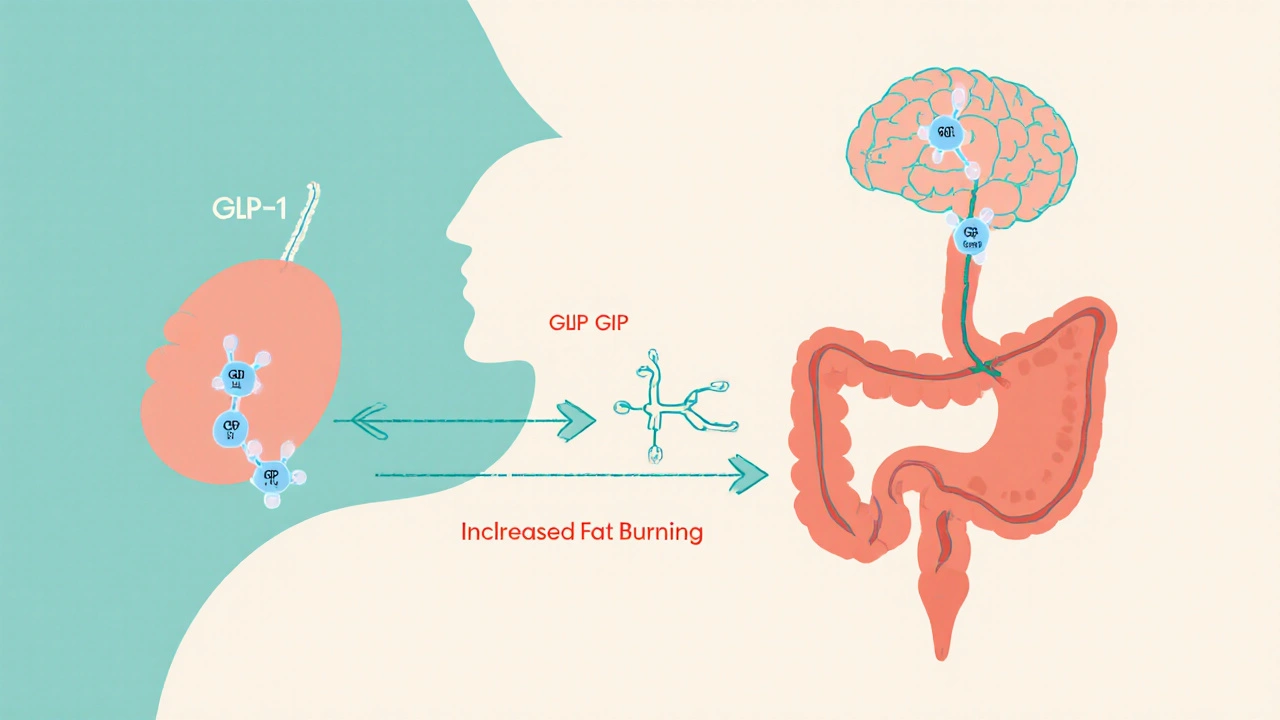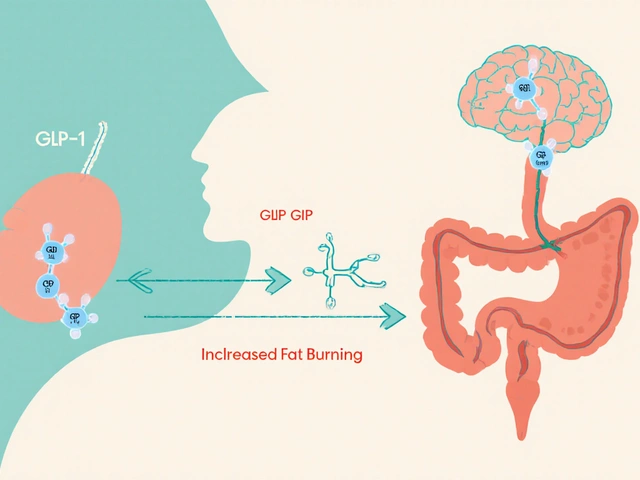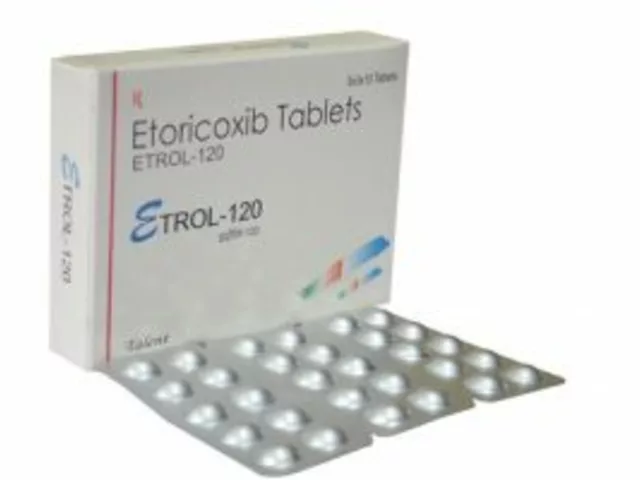When you hear about tirzepatide for weight loss, you’re not just hearing about another diet pill. You’re hearing about a breakthrough that’s changing how doctors treat obesity. Unlike older weight-loss drugs that only target one hormone, tirzepatide hits two at once - and that’s what makes the difference.
What Is Tirzepatide?
Tirzepatide is a synthetic peptide that mimics two natural hormones in your body: GLP-1 (glucagon-like peptide-1) and GIP (glucose-dependent insulinotropic polypeptide). These are called incretin hormones because they help your body respond to food. They tell your pancreas to release insulin when blood sugar rises, and they send signals to your brain to feel full.
Before tirzepatide, most weight-loss drugs like semaglutide (Wegovy) only worked on GLP-1. Tirzepatide is the first drug to combine both. That’s why it’s called a dual incretin agonist - or sometimes a twincretin. It’s not just an upgrade. It’s a new category of treatment.
It’s sold under two names: Mounjaro for type 2 diabetes and Zepbound for chronic weight management. The FDA approved Zepbound for weight loss in November 2023. Since then, over 1.2 million people in the U.S. have started using it.
How Does It Actually Help You Lose Weight?
Tirzepatide doesn’t just make you eat less. It changes how your body stores and uses energy.
- Slows stomach emptying - Food stays in your stomach longer, so you feel full after smaller meals.
- Reduces appetite signals - It acts on the hypothalamus, the part of your brain that controls hunger. You don’t feel cravings as strongly.
- Boosts insulin sensitivity - Your body uses glucose more efficiently, which helps reduce fat storage.
- Increases adiponectin - This hormone helps burn fat and reduces inflammation in fat tissue.
- Improves energy use - Early research suggests it may slightly increase your resting metabolic rate, meaning you burn more calories even at rest.
In clinical trials, people using the highest dose (15 mg weekly) lost an average of 22.4% of their body weight over 72 weeks. That’s not a few pounds - that’s over 50 pounds for someone who weighs 250. For comparison, semaglutide (Wegovy) led to about 14.9% weight loss in the same timeframe.
Why Is Dual Action Better Than Single?
Here’s the key: GLP-1 alone works well. But adding GIP makes it work better.
Studies from Duke University showed that when both receptors are activated together, the effect isn’t just added - it’s multiplied. GIP helps insulin work more effectively in fat and muscle tissue. It also helps reduce fat accumulation in the liver. GLP-1 handles appetite and insulin release. Together, they create a broader metabolic reset.
One surprising finding: people on tirzepatide lost more fat mass than those on semaglutide - even when their appetite scores were similar. That means tirzepatide isn’t just making you eat less. It’s changing how your body holds onto fat.
What Does the Dosing Look Like?
You don’t start at 15 mg. That’s the goal, but you get there slowly.
The FDA-approved titration schedule takes 20 weeks:
- Weeks 1-4: 2.5 mg once a week
- Weeks 5-8: 5 mg
- Weeks 9-12: 7.5 mg
- Weeks 13-16: 10 mg
- Weeks 17-20: 15 mg
Most people don’t rush this. Skipping steps or increasing too fast leads to side effects. In fact, 38% of patients need extra time at the 5 mg or 10 mg stages because their stomachs need to adjust.
You inject it yourself, once a week, under the skin - abdomen, thigh, or upper arm. It comes in a pre-filled pen. No refrigeration needed after the first use. Just store it in the fridge before opening.

Side Effects: What to Expect
The biggest issue isn’t the weight loss - it’s the stomach upset.
- Nausea - Affects 20-25% of users, especially during dose increases.
- Vomiting - Around 7-10%.
- Diarrhea - 15-18%.
These aren’t rare. But they’re usually mild and fade over time. People who stick with the slow titration schedule report far fewer problems. One Reddit user wrote: “I was sick at 10 mg. I dropped back to 7.5 for two weeks. Then I tried again. Now I’m at 15 mg and feel great.”
Some people can’t tolerate it. About 32% of users in one study stopped because of side effects. If you have a history of severe nausea, gastroparesis, or pancreatitis, talk to your doctor first.
There’s also a black box warning about thyroid tumors - based on rodent studies. No human cases have been confirmed, but if you or a family member has had medullary thyroid cancer, you shouldn’t take it.
Real People, Real Results
Across 2,145 patient reviews on WebMD, Healthline, and GoodRx, 68% lost at least 15% of their body weight by six months. The average rating is 8.2 out of 10.
u/HealthyJourney89 on Reddit lost 58 pounds in six months on 15 mg. “I didn’t feel hungry. I didn’t obsess over food. It felt like my body finally stopped fighting me.”
But others aren’t as lucky. u/StrugglingWithSideEffects said: “I had to stop at 10 mg. The nausea was unbearable. I lost 12 pounds, but I couldn’t keep going.”
The difference? Timing. People who followed the full 20-week schedule had much better outcomes. Rushing = more side effects.
Cost and Access
The list price is over $1,000 per month. But that’s not what most people pay.
Thanks to Lilly’s co-pay assistance program and insurance coverage, 89% of commercially insured patients pay under $100 a month. Many pay as little as $45. Medicare coverage varies by plan, but more plans are adding it in 2025.
There’s also a patient support program called Lilly Cares that helps people without insurance get the medication for free - if they meet income requirements.

What Happens When You Stop?
This is the big question everyone asks.
Weight loss from tirzepatide is maintained only while you’re taking it. In extension studies, people who stopped gained back 12-15% of the weight they lost within six months. That’s not failure - it’s biology.
Obesity is a chronic condition, like high blood pressure. You don’t stop taking blood pressure meds just because your numbers are normal. Same here.
Some experts suggest combining tirzepatide with lifestyle changes - not to replace the drug, but to make the results last longer. Even after stopping, people who kept up with healthy eating and movement regained less weight.
What’s Next?
Tirzepatide is already being used for more than weight loss. In October 2024, the FDA approved it for treating obstructive sleep apnea in adults with obesity. That’s huge - because it’s the first weight-loss drug approved specifically for a sleep disorder.
Lilly is also testing it for non-alcoholic steatohepatitis (NASH), a fatty liver disease linked to obesity. Early results show improvement in liver fat and inflammation.
And they’re not stopping there. Their next drug, retatrutide, targets three hormones: GLP-1, GIP, and glucagon. Phase 2 results showed 24.2% weight loss in just 24 weeks. That’s even more than tirzepatide.
This isn’t just a new drug. It’s the start of a new era in obesity treatment - one that uses multiple biological pathways to reset metabolism, not just suppress appetite.
Who Should Consider It?
You might be a good candidate if:
- You have obesity (BMI ≥ 30) or overweight (BMI ≥ 27) with at least one weight-related condition like high blood pressure, diabetes, or sleep apnea.
- You’ve tried diet and exercise but haven’t reached your goal.
- You’re willing to stick with a slow, careful dosing schedule.
- You don’t have a personal or family history of medullary thyroid cancer.
It’s not for everyone. But for those who can tolerate it, it’s the most effective weight-loss medication ever approved.
How long does it take to see weight loss with tirzepatide?
Most people start seeing results within 4 to 8 weeks, but the biggest changes happen after 16 to 24 weeks. Clinical trials showed the most significant weight loss occurred at the 72-week mark. Patience is key - this isn’t a quick fix.
Can I take tirzepatide if I’m not diabetic?
Yes. Tirzepatide is approved under the brand name Zepbound specifically for chronic weight management in adults with obesity or overweight, regardless of whether they have type 2 diabetes. The dose and schedule are the same as for Mounjaro.
Is tirzepatide better than semaglutide for weight loss?
Yes, in head-to-head trials, tirzepatide led to significantly more weight loss. At the highest dose, tirzepatide users lost 22.5% of their body weight on average, compared to 14.9% with semaglutide. It also reduced more fat mass and improved insulin sensitivity more effectively.
Do I need to change my diet while taking tirzepatide?
You don’t have to follow a strict diet, but eating smaller, lower-fat meals helps reduce side effects like nausea. Many people naturally eat less because they feel full faster. Combining the medication with balanced nutrition and regular movement leads to better, longer-lasting results.
Can tirzepatide cause pancreatitis?
Pancreatitis is a rare but possible side effect, as it is with other GLP-1 drugs. In clinical trials, the rate was very low - less than 0.1%. If you experience severe, persistent abdominal pain that radiates to your back, stop the medication and seek medical help immediately.
Final Thoughts
Tirzepatide isn’t magic. It won’t work if you skip doses or rush the titration. It won’t fix years of unhealthy habits overnight. But it does give you a powerful tool - one that works with your body, not against it.
For the first time, we have a medication that doesn’t just suppress hunger. It resets how your body manages energy, fat, and insulin. That’s why it’s changing the game.
If you’re considering it, talk to your doctor. Ask about your BMI, your health history, and whether the side effects are manageable for you. And remember - the goal isn’t just to lose weight. It’s to live better, longer, and healthier.








Andrew Forthmuller November 11, 2025
tirzepatide sounds like magic but i still dont trust it. why does my body need a chemical to tell me im full? i used to just eat less and move more. now its all pills and potions.
vanessa k November 13, 2025
I get why people are excited, but the side effects are no joke. My cousin tried it and was puking for weeks. She dropped to 7.5mg and still felt like garbage. This isn’t a quick fix-it’s a lifestyle overhaul with a needle.
manish kumar November 14, 2025
Guys, let’s not forget this isn’t just about weight loss-it’s about metabolic reprogramming. Tirzepatide doesn’t just suppress appetite; it recalibrates your body’s entire energy storage system. The GIP component is the real game-changer. Most people think it’s just another GLP-1, but no-it’s the dual action that reduces liver fat, improves insulin sensitivity in muscle tissue, and even alters adiponectin levels. This is the future of obesity medicine. We’re not just losing pounds-we’re reversing metabolic dysfunction. And yes, the titration is slow for a reason. Rush it and you’ll regret it. Patience isn’t optional-it’s therapeutic.
Arpita Shukla November 14, 2025
Anyone who says this is better than semaglutide hasn’t read the full trial data. The 22.4% weight loss? That’s at 15mg. But 32% of people dropped out because of nausea. So really, it’s only better for the 68% who tolerate it. Also, the cost? Even with copay programs, it’s still a $1000/month drug for those without insurance. And don’t get me started on the black box warning. Rodent tumors? That’s not nothing.
Benjamin Stöffler November 14, 2025
Here’s the uncomfortable truth: we’ve turned obesity into a pharmacological problem instead of a cultural one. We’ve got people injecting peptides to fix a diet culture that’s been poisoning us for decades. Tirzepatide doesn’t solve why we eat; it just masks the symptoms. And now, we’re already moving on to retatrutide-three hormones!-because we’re addicted to the idea that biology can be hacked with a new molecule. We’re not healing. We’re optimizing. And that’s a tragedy disguised as progress.
Mark Rutkowski November 16, 2025
This isn’t a drug-it’s a reset button. For the first time, we’re not fighting our biology, we’re speaking its language. GLP-1 and GIP? They’re not foreign chemicals. They’re the body’s own signals, amplified. This is like giving your pancreas and brain a pep talk instead of a slap. And yeah, the nausea sucks-but so did every diet you’ve ever tried. This one actually works. Not because it’s magic, but because it’s honest. It doesn’t lie to you. It just says: ‘You’re full. Stop eating.’ And for people who’ve spent years screaming at their own hunger? That’s peace.
Ryan Everhart November 17, 2025
So let me get this straight-we’ve got a drug that makes you lose 50 lbs, but you have to wait 20 weeks to get to the dose that works… and half the people can’t handle the side effects… and you gain it all back if you stop… and it costs a fortune… and there’s a black box warning… and yet everyone’s acting like it’s the second coming? I’m just here for the popcorn.
David Barry November 19, 2025
Let’s be real: this drug works because it makes you sick. Nausea isn’t a side effect-it’s the mechanism. You don’t eat because you feel like crap. The ‘fullness’ is just a placebo wrapped in peptides. The real weight loss comes from vomiting and diarrhea. Don’t romanticize it. It’s a chemical leash.
Nicole M November 19, 2025
Does anyone know if it’s safe to take with thyroid meds? My endo said yes but I’m nervous. Also, how long does the pen last once opened? I’m scared I’ll mess it up.
Alyssa Lopez November 21, 2025
Why are we letting Big Pharma dictate our health? This is just another way to make fat people feel broken so they’ll buy $1000/month needles. We need to fix the food system-not inject people with synthetic hormones. This isn’t medicine, it’s capitalism with a syringe.
Alex Ramos November 21, 2025
Just finished week 12 at 7.5mg. Lost 32 lbs. Nausea was brutal at 5mg but eased up after slowing down. I’m now at 10mg and feel amazing. No cravings. Sleep is better. My BP is normal. This isn’t a miracle-it’s science. And yeah, I’ll keep taking it as long as my doc says. I’m not ashamed. My body needed help. I’m grateful it exists.
Erica Cruz November 22, 2025
Oh please. You all act like this is the first time someone’s lost weight with a drug. Remember phentermine? Fen-phen? All the hype, all the crashes. This is just the same story with a fancier label. And don’t get me started on the ‘metabolic reset’ nonsense. Your metabolism doesn’t need resetting-it needs food. Real food. Not a $1000/week injection that turns your stomach into a warzone. People are dying from these drugs. Literally. And we’re cheering like it’s a new iPhone.